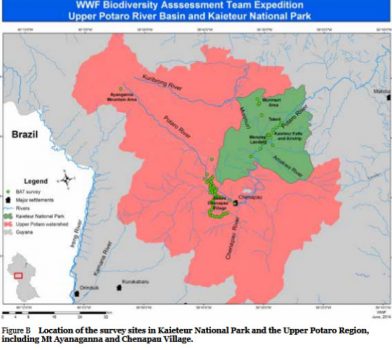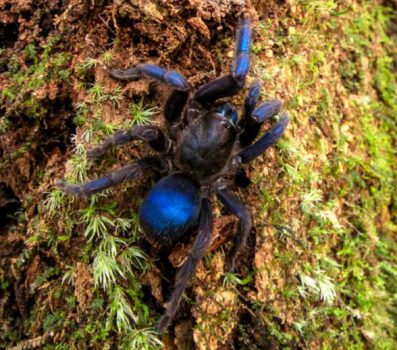A recent Biodiversity Assessment Team (BAT) survey of the Kaieteur National Park (KNP) and the Upper Potaro area has led to the discovery of up to 31 new or potentially new species to science.
The BAT Report, the second of a three-part series, lists 31 new or potentially species, including plants, fishes and insects. These comprise three plant species, five dragonfly and damselfly species, 15 aquatic beetle species, two crustacean species and six fish species. However, it notes that species identifications were still being taxonomically finalised at the time the report was prepared.
At the launch of the report last Thursday evening at the Cara Lodge, Country Manager of the World Wildlife Federation (WWF) Guyana Aiesha Williams noted that the group of local and international researchers which ventured deep into the areas in 2014 went in search of new data on the different groups of animals as well as the quality of the water.
“We have set aside this evening to showcase our Guyana through its biodiversity. It is one thing to conduct scientific work but if we don’t communicate and engage in an appropriate manner with various groups then there is only so much we can achieve for conservation,” Williams said.

Williams further explained that for some of the groups, the data collected was the first documentation for species diversity within the landscape, while for others, it strengthened already existing information. The information, she said, should be used by all stakeholders to enrich existing data and spur further research, which can be used to make informed decisions on land use, good environmental governance, freshwater management and the sustainable use of region’s natural resources.
“Our expert team deliberately ensured a strong science based approach, and all users of the information can truly trust and rely on what is provided, making the data invaluable for planning purposes,” she said.

The surveys were conducted over freshwater, river and forest systems in various elevation levels, up to a peak of 270 meters above sea level. The team surveyed the KNP and its environs, the vicinity of the Kaieteur Falls, the Upper Potaro Region, around the Amerindian Village of Chenapau, and around the foot of Mount Ayanganna.
Williams explained that further analyses are being done to confirm whether the newly discovered organisms are new to science.
“If you ask scientists, this adds to the areas’ enormous conservation value. If we are still making new records of species then there could be more there. Not to mention the benefits to us are largely unknown,” Williams noted, while pointing out that some species were also recorded for the first time in Guyana.
In addition to the areas’ rich biodiversity, Williams highlighted that it is an important aspect to the Patamona People, who rely on it to live and for their cultural and spiritual practices.
“With such tremendous importance for nature and people, it is extremely important that the exploitation and other developmental activities within the area is based on the principle of using natural resources in a well-planned and sustainable [manner]. The fact that we are finding new species and the landscape is known for species that are found nowhere else, and that the Patamona People have ancestral ties and depend on the space for their wellbeing, shows that we have to act more earnestly in maintaining the area,” Williams charged.
On that note, Juliana Persaud, from the WWF Guyana Office, elaborated on the recommendations that had been compiled from the different areas of survey by the researchers.
Persaud explained that the recommendations weigh heavily on the regulation of mining activities in the vicinity of the areas, which have impacts that stretch far and wide to various communities.
“….So as we heard this evening, the Kaieteur and Upper Potaro areas are incredibly valuable from a biodiversity standpoint with new and endemic species. And it is also critical because it provides really important ecosystem services, and at the same time in the area we have gold mining, which is an important livelihood activity for communities,” Persaud said, while pointing out that there needs to be a reconciliation of the goal of environmental protection with the goal of mining.
From such a reconciliation, the implementation of mining best practices, inclusive of taking innovative steps to reduce and eliminate the use of mercy in gold mining, should be paramount. “This is not a simple task which can be undertaken by one or two agencies, but really calls for a well-defined and inclusive effort from all stakeholders,” Persaud noted.
She explained that there should be a water quality monitoring system put in place in the long term and it should not only be focused on the KNP, but beyond, since fresh water contamination outside of the National Park means that the Potaro River, which flows through the park, will become contaminated, which will have far reaching impacts on the surrounding biodiversity and nearby communities.
She also she stated that it is necessary for other ecological changes to be measured and to be incorporated in land use and decision making.
In addition, Persaud said the development of an alternative livelihood plan should also be pursued and promoted, and the options should be feasible for the communities and must be fully developed, from the bottom all the way to the top.
“Some local folks are already employees with the Kaieteur National Park and there are many other opportunities that exist and must be fully assessed,” she noted. Presentations were also made by Dr. Brian O’Shea, who spoke about the bird population and discoveries; Dr. Andrew Snyder, who presented on the Amphibian and Reptilian population and discovery, and Meshach Pierre, a graduate of the University of Guyana, who spoke on Medium and Large Mammals of the Upper Potaro.
Commissioner of the Protected Areas Commission Denise Fraser also made brief remarks and related that the agency is of the opinion that the Guyanese population needs to have a greater sense of appreciation and pride for the beauty of the hinterland areas and the value of the diversity of the land.
The full BAT survey report is available for download at http:/ /wwf.panda.org/wwf_news/?316770%2FBAT-Survey-Report-No-2#




